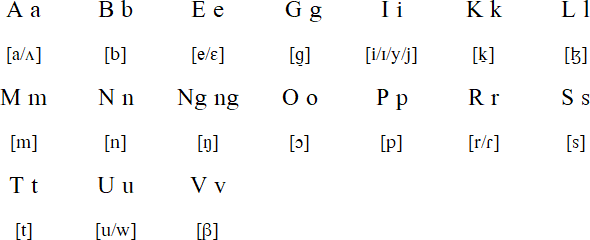Tigak is a member of the Western Oceanic branch of Malayo-Polynesian language family. It spoken by about 10,000 people in the west of Djaul Island in the Kavieng District of New Ireland Province in the northeast of Papua New Guinea.
Tigak is also known Omo. It is written with the Latin script, and is taught in primary schools. A translation of the New Testament in Tigak was completed in 2019.

Download an alphabet chart for Tigak (Excel)
Kus paratung, paralang ani a tamatene tivunan. Ri lapun, riga pisingiri pana ri karak, ve a va tivuri na Levaravu ve na Levarava. Va lakeak gura rek kalkalum malan tana palmit sakai a masat tana karek tangintol. Io, aisok te ri tivurek ina kavaiirek ve tavaiirek pana pok, ve kavulirek alu. A malmalasup ina 'kavul' gi malan tana rik tavaiirek pana ta kematan takteak vo rik vil apolokirek. Io, rega polok paspasal, ve ri lapun riga kalumirek rek polok paspasal, ve riga nangas tana kari akotong tana va tivuri, ve riga kusirek auneng, "Vo muk karau ve ga togon sakai anu riga pisingi pe Taugui. Anu gura ga anu ngangan ve nane ga togon tukul sula alu lo tuana tukul sula tatara.
A folk tale which tells about a grandmother and grandchildren. An old woman who is called 'old lady' and her two grandchildren who are called Leverava and Levaravu. These two children appear to be about six years old. Well, their grandmother's work is to look after them, and give them food to build them up as well. The meaning of 'build up' (kavul) is that she should give them some strength and make them grow. Well, they kept on growing and she was pleased with her care of her two grandchildren and she told them this, "You will be playing and there is a man called Taugui. This man is a cannibal and he has a bamboo patch too, in the middle of our bamboo patch.
Source: Tigak Organised Phonology Data
Information about Tigak | Numbers
Information Tigak
https://en.wikipedia.org/wiki/Tigak_language
https://www.ethnologue.com/language/tgc
https://www.sil.org/resources/search/language/tgc
https://www.semanticscholar.org/paper/The-Tigak-language-of-New-Ireland-Beaumont/0e8671bc1b8e80a15b7b12f1e3f03be3e1aeff4e
Tigak dictionary
http://www.surrey.ac.uk/lcts/bill.palmer/NWS_site/Rov/RovDic.pdf
Adzera, Ahamb, Äiwoo, Aneityum, Apma, Araki, Are, ʼAuhelawa, Avava, Babatana, Bariai, Bola, Big Numbas, Buhutu, Bwaidoka, Caac, Cheke Holo, Daakaka, Dorig, Hiri Motu, Hiw, Hoava, Kakabai, Kaninuwa, Kokota, Koro. Kove, Kurti, Kwamera, Lakon, Lehali, Lenakel, Lewo, Lote, Lo-Toga, Löyöp, Manam, Marovo, Maskelynes, Mato, Mavea, Mono-Alu, Mota, Motu, Mussau-Emira, Mwerlap, Mwotlap, Nafsan, Nahavaq, Namakura, Naman, Nanggu, Nduke, Neve‘ei, Neverver, Ninde, North Efate, Nume, Paamese, Papapana, Raga, Rotuman, Roviana, Sa, Sakao, Saliba, Siar, Sio, Ske, Sobei, Sursurunga, Tamambo, Tami, Teanu, Tigak, Tirax, Tolai, Touo, Ubir, Ughele, Uneapa, Vatlongos, Vitu, Vurës, Western Fijian, Yabem, Yapese
Languages written with the Latin alphabet
Page created: 20.12.22. Last modified: 21.12.22
[top]
You can support this site by Buying Me A Coffee, and if you like what you see on this page, you can use the buttons below to share it with people you know.

If you like this site and find it useful, you can support it by making a donation via PayPal or Patreon, or by contributing in other ways. Omniglot is how I make my living.
Note: all links on this site to Amazon.com, Amazon.co.uk
and Amazon.fr
are affiliate links. This means I earn a commission if you click on any of them and buy something. So by clicking on these links you can help to support this site.
[top]